Orthopedic Software Market Size and Share
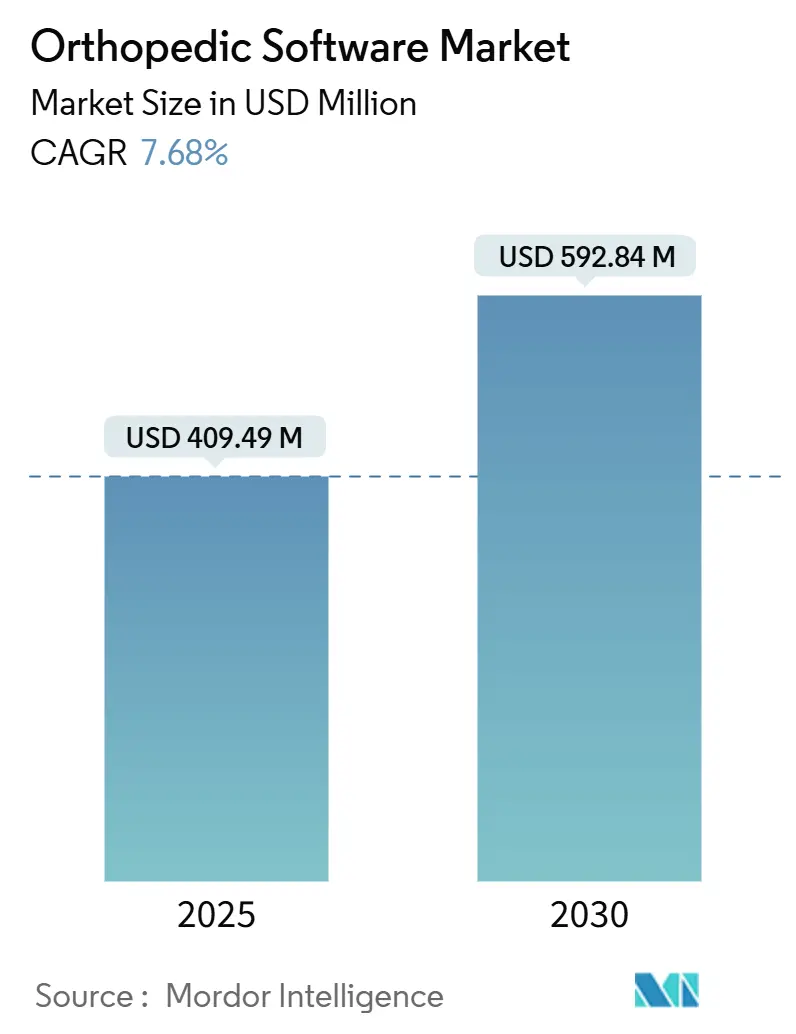
Orthopedic Software Market Analysis by Mordor Intelligence
The Orthopedic Software Market size is estimated at USD 409.49 million in 2025, and is expected to reach USD 592.84 million by 2030, at a CAGR of 7.68% during the forecast period (2025-2030).
Widespread digitization of orthopedic care, the rapid maturation of artificial intelligence (AI), and the enforcement of interoperability rules are pushing specialty clinics and large hospital systems toward integrated software ecosystems that manage imaging, surgical planning, and revenue-cycle tasks. Vendors that provide AI-driven decision support and secure cloud deployment continue to capture demand from practices looking to shorten operating-room time, lower revision rates, and tap new value-based reimbursement streams. Aging populations in high-income countries, surging ambulatory surgery center (ASC) volumes, and expanding use of robotic guidance further sustain double-digit growth in key sub-segments. Competitive intensity is rising as hardware majors enter software niches, yet the market remains fragmented, allowing mid-tier developers to gain share through niche innovations and regional partnerships.
Key Report Takeaways
- By product type, digital templating captured 35.83% of orthopedic software market share in 2024, while orthopedic PACS is projected to expand at a 9.71% CAGR through 2030.
- By mode of delivery, cloud deployments commanded 59.32% share of the Orthopedic software market size in 2024, and the same model is forecast to grow at an 11.95% CAGR to 2030.
- By application, orthopedic surgery held 36.91% of the orthopedic software market size in 2024, whereas fracture management will record the fastest 12.29% CAGR between 2025-2030.
- By end user, hospitals accounted for 55.78% share of the orthopedic software market in 2024, while orthopedic clinics are poised for the highest 13.62% CAGR to 2030.
- By geography, North America led with 39.85% revenue share in 2024; Asia-Pacific is expected to post a 13.15% CAGR through 2030.
Global Orthopedic Software Market Trends and Insights
Drivers Impact Analysis
| Driver | (~) % Impact on CAGR Forecast | Geographic Relevance | Impact Timeline |
|---|---|---|---|
| Aging Population Boosting Osteoarthritis & Fracture Case-Load | +1.8% | Global, with concentration in North America & Europe | Long term (≥ 4 years) |
| Rapid Shift to Ambulatory & Minimally-Invasive Orthopedic Surgery | +1.5% | North America & Europe, expanding to APAC | Medium term (2-4 years) |
| Mandatory EHR / PACS Interoperability | +1.2% | North America & EU regulatory zones | Short term (≤ 2 years) |
| 3-D Digital Templating Proven to Cut Implant Revision Rates | +1.0% | Global, early adoption in developed markets | Medium term (2-4 years) |
| AI Auto-Templating Reduces Sterile Tray Inventory | +0.8% | North America & Europe, pilot programs in APAC | Medium term (2-4 years) |
| Ortho-Software API Marketplaces Unlocking New SaaS Revenue for Clinics | +0.6% | North America, expanding globally | Long term (≥ 4 years) |
| Source: Mordor Intelligence | |||
Aging Population Boosting Osteoarthritis & Fracture Case-Load
Global populations aged 65+ continue to expand, driving up degenerative joint disease and fracture incidence that strain manual workflows. Digital templating decreases surgical time by 15-20% and improves implant placement accuracy, helping surgeons handle higher caseloads without compromising outcomes.[1]Journal of Clinical Medicine Editors, “Digital Templating in Total Hip Arthroplasty Improves Accuracy,” mdpi.com AI-driven imaging reaches over 90% diagnostic accuracy for early bone pathology detection, enabling proactive interventions that ease long-term cost pressures. Integrated revenue-cycle modules streamline complex geriatric billing, improving margin security for practices facing payer scrutiny.
Rapid Shift to Ambulatory & Minimally-Invasive Orthopedic Surgery
ASC volumes are climbing at 6.9% annually, with orthopedic outpatient procedures projected to grow 13% this decade. These settings require cloud-native software that supports rapid turnover, small operating suites, and tight capital budgets. CMS approval of shoulder replacements for outpatient reimbursement accelerates adoption of advanced planning tools. Only 54.6% of ASCs presently operate certified EHRs, signaling a sizable addressable market for specialty vendors.
Mandatory EHR / PACS Interoperability
The 21st Century Cures Act penalizes information blocking, forcing orthopedic groups to deploy standards-based solutions capable of exchanging clinical data across disparate systems.[2]U.S. Department of Health & Human Services, “21st Century Cures Act Information Blocking Final Rule,” hhs.gov Practices now prioritize FHIR-enabled platforms that integrate radiology images, operative notes, and billing details in a single record. Vendors offering turnkey APIs gain preference as clinics weigh compliance risk against cost.
3-D Digital Templating Proven to Cut Implant Revision Rates
Evidence shows 3-D planning reduces revision surgeries, which cost hospitals two to three times more than primary procedures. AI-assisted templating aligns pre-operative planning with intra-operative robotic guidance, delivering sub-millimeter precision. Economic payback strengthens when templating data feed custom implant workflows that reduce inventory waste and post-op complications.
Restraints Impact Analysis
| Restraint | (~) % Impact on CAGR Forecast | Geographic Relevance | Impact Timeline |
|---|---|---|---|
| Shortage of orthopedic informatics & imaging IT specialists | -1.5% | Global — acute in rural and emerging markets | Long term (≥ 4 years) |
| High capital cost and workflow disruption during system migration | -1.2% | Global — smaller practices most affected | Short term (≤ 2 years) |
| Complex HIPAA / GDPR compliance for cloud data hosting | -0.8% | North America & EU regulatory zones | Medium term (2-4 years) |
| Soaring cyber-insurance premiums after ransomware incidents | -0.6% | Global — developed markets see largest hikes | Short term (≤ 2 years) |
| Source: Mordor Intelligence | |||
Shortage of Orthopedic Informatics & Imaging IT Specialists
Advanced EHR rollouts require up to 153,114 additional IT full-time equivalents worldwide, yet training pipelines lag demand. Specialty clinics in rural settings depend on vendor services, elevating deployment cost and elongating timelines. Vendors that bundle implementation, training, and managed services thus gain a strategic edge.
Soaring Cyber-Insurance Premiums after Ransomware Incidents
The February 2024 Change Healthcare breach compromised 190 million patient records and elevated cyber-insurance premiums by 25-50%.[3]Change Healthcare Cybersecurity Update, “Impact Analysis of the February 2024 Ransomware Event,” bankinfosecurity.com Small orthopedic groups struggle to finance coverage that now requires multi-factor authentication, zero-trust architectures, and vendor redundancy proofs. Software suppliers with robust encryption and certified security programs are increasingly specified in procurement tenders.
Segment Analysis
By Product Type: Digital Templating Sets the Benchmark for Clinical Precision
Digital templating held a 35.83% orthopedic software market share in 2024, reflecting its proven ability to lower revision rates and trim operating-room minutes. The sub-segment benefits from AI image-segmentation modules that learn from prior cases, yielding standardized implant plans and reducing inter-surgeon variability. Orthopedic PACS is projected to post a 9.71% CAGR, fueled by climbing MRI and CT volumes and regulatory moves to eliminate film. Revenue-cycle tools remain essential as value-based contracts rise, while integrated EHRs embed specialty decision support tailored to musculoskeletal workflows. Patient-engagement apps that sync rehab milestones into the clinical record close the feedback loop, supporting bundled-payment compliance.
Complementary modules converge around an open-API backbone that unifies scheduling, imaging, and OR inventory control. Vendors now deploy cloud functions for 3-D rendering, offloading compute workload from local servers. As digital templating exports structured data to robotics consoles, intra-operative adjustments shrink and post-operative alignment scores improve. The Orthopedic software market size tied to templating and PACS is forecast to expand at a steady 8-9% pace, underpinned by a backlog of elective cases deferred during pandemic years.
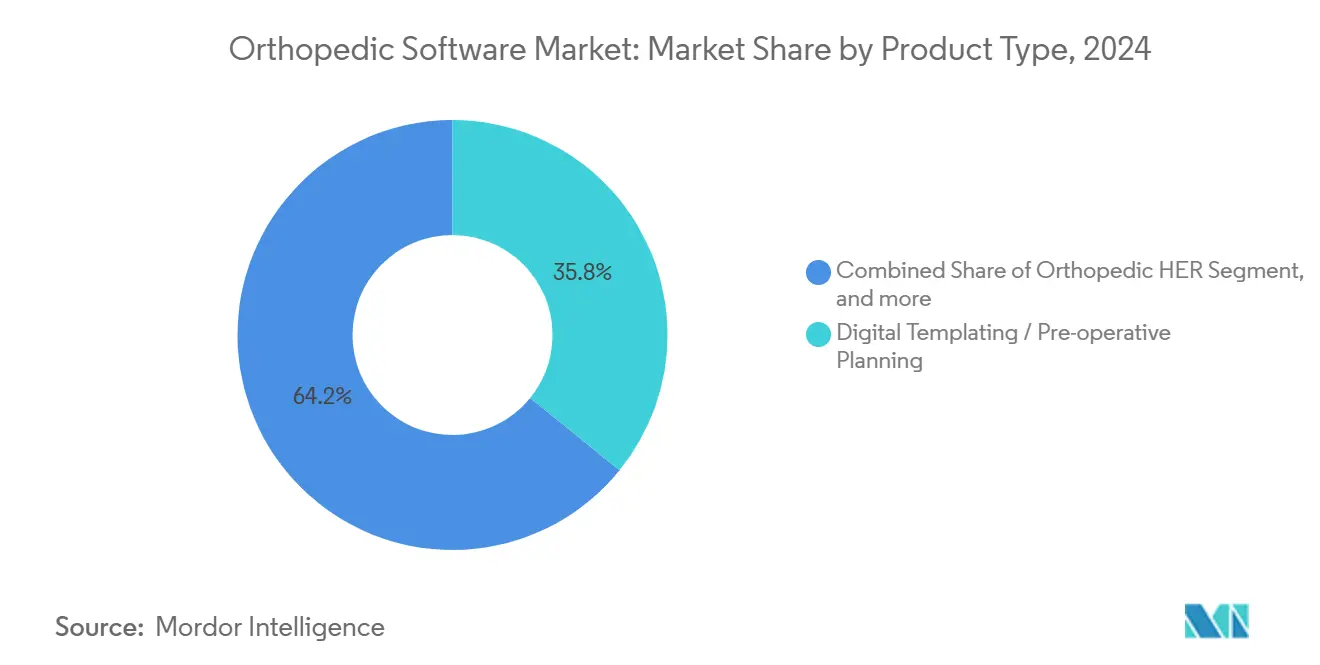
Note: Segment shares of all individual segments available upon report purchase
By Mode of Delivery: Cloud Dominance Accelerates Scalability
Cloud deployments comprised 59.32% of the orthopedic software market in 2024 and are tracking an 11.95% CAGR to 2030. Subscription pricing aligns with ASC cashflows and shields smaller clinics from large capital outlays. Vendors emphasize zero-downtime upgrades and encrypted edge-to-cloud sync, overcoming earlier fears of latency and data sovereignty. Hybrid models remain relevant for academic centers that house sensitive research images onsite while using cloud analytics for AI model-training.
On-premise systems persist where wide-area bandwidth is limited or data guardianship rules forbid offsite storage. Even here, suppliers offer modular gateways that mirror datasets to disaster-recovery clouds. As public cloud providers win HIPAA and GDPR attestations, holdouts are expected to convert. The Orthopedic software market size attributed to cloud software will likely exceed USD 350 million by 2030 if current adoption curves hold.
By Application: Fracture Management Leads Future Growth
Orthopedic surgery applications generated the largest revenue share at 36.91% in 2024, yet fracture management will lead expansion with a 12.29% CAGR. AI algorithms that spot subtle cortical disruptions on X-ray and quantify callus formation on follow-up CT foster earlier interventions and optimized fixation strategies. Joint-replacement modules harness robotic navigation to improve cup and stem orientation, while pediatric assessment tools automate bone-age scoring, supporting endocrine-orthopedic collaboration.
Sports-medicine clinics integrate wearable telemetry with postoperative dashboards, extending visibility into at-home rehabilitation. Such end-to-end datasets feed predictive analytics that flag patients at risk of delayed union or prosthesis loosening. The Orthopedic software market share linked to fracture management will widen as trauma volumes climb in rapidly urbanizing economies.
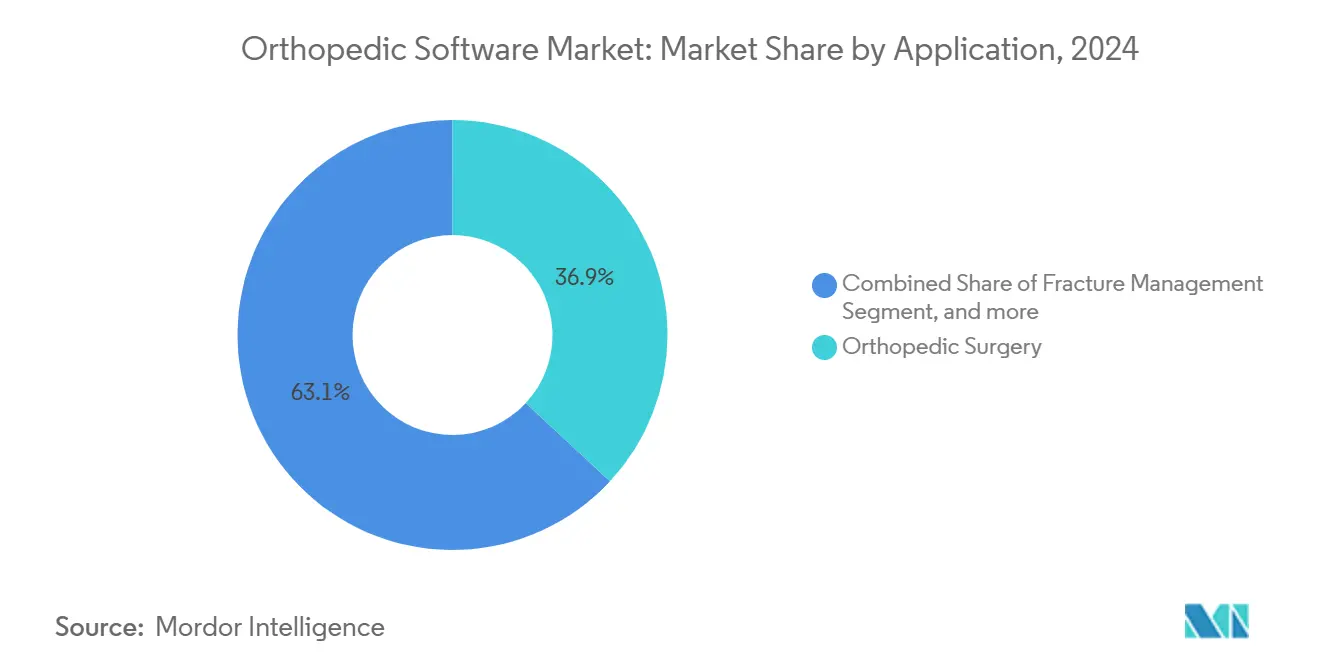
Note: Segment shares of all individual segments available upon report purchase
By End User: Clinics Outpace Hospitals in Percentage Growth
Hospitals represented 55.78% of 2024 spending, reflecting enterprise-wide rollouts that integrate imaging, operative, and billing workflows. Yet independent orthopedic clinics will see the fastest 13.62% CAGR through 2030 as they invest in specialty EHRs to secure payer recognition and compete with health-system-owned practices. ASC operators prize cloud deployment for rapid scaling into newly accredited procedure rooms. Academic institutes leverage open-source APIs for research analytics and AI validation, forging partnerships with software vendors to co-develop algorithms.
Smaller practices gravitate toward turnkey platforms bundling digital templating, practice management, and patient engagement in one contract. This reduces vendor sprawl and simplifies cyber-insurance compliance. The Orthopedic software market size derived from clinics is forecast to nearly double within five years, cementing them as a vital growth channel for suppliers.
Geography Analysis
North America accounted for 39.85% of total revenue in 2024 thanks to established reimbursement pathways and mature cloud infrastructure. U.S. Medicare policies reward digital documentation that supports quality metrics, encouraging practices to adopt integrated solutions. Canada’s provincial mandates for electronic data sharing further entrench demand, and cross-border vendor relationships ease technology transfers.
Asia-Pacific is registering the strongest 13.15% CAGR. China’s Healthy China blueprint funds digital health pilots, positioning provincial hospitals as early adopters. Japan utilizes robotics and AI to offset surgical labor shortages, while India’s public-private partnerships finance cloud EHRs in tertiary trauma centers. Regional heterogeneity favors modular, language-localised platforms that comply with divergent privacy statutes.
Europe’s steady adoption is led by Germany, where federal grants subsidize orthopedic digitization in clinics complying with stringent GDPR controls. The U.K.’s NHS Interoperability program specifies FHIR messaging for orthopedic referrals, giving vendors with proven data-exchange workflows a head start. France channels innovation budgets toward coordinated care networks that require real-time image routing from outpatient radiology to orthopedic wards. Across the bloc, evidence of lower revision rates is pivotal to investment sign-off, placing data-rich suppliers in an advantageous position.
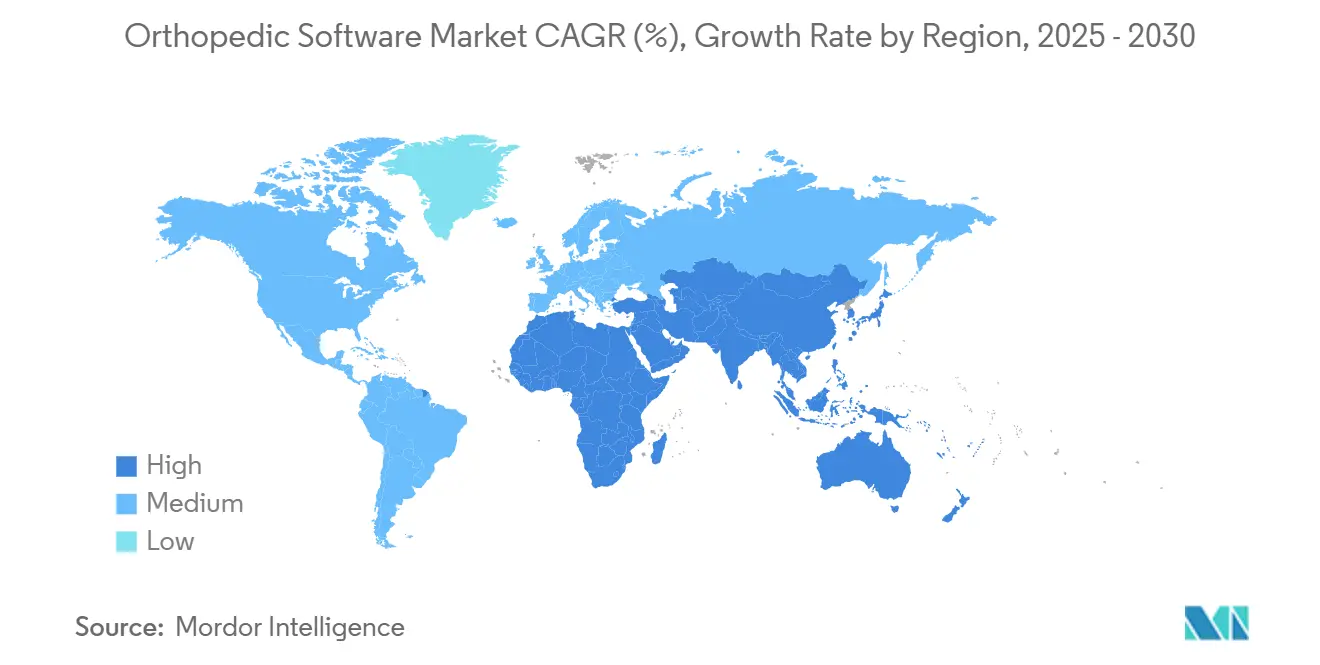
Competitive Landscape
Competitive rivalry is moderate. Top hardware incumbents leverage installed imaging bases to upsell software overlays, while independent developers win share in niche areas like pediatric templating. Stryker’s six acquisitions averaged USD 817 million in 2024, adding AI navigation to its Mako platform and broadening its software stack. GE HealthCare’s Genesis launch illustrates hardware-agnostic imaging SaaS, aiming to triple cloud-enabled modules by 2028. Brainlab’s planned EUR 200 million IPO underscores the shift toward subscription revenue and continuous feature rollout.
White-space gaps persist in low-resource markets and subspecialties such as limb deformity analysis. New entrants deliver API marketplaces where third-party apps plug into core records, creating an ecosystem effect that entrenches platform providers. Partnerships between device makers and cloud hyperscalers accelerate AI model training and global distribution, while cybersecurity remains a gating criterion for contract awards.
Orthopedic Software Industry Leaders
-
Materialise NV
-
GE Healthcare
-
Medstrat Inc.
-
IBM Corporation (Merge Healthcare Inc.)
-
Brainlab
- *Disclaimer: Major Players sorted in no particular order
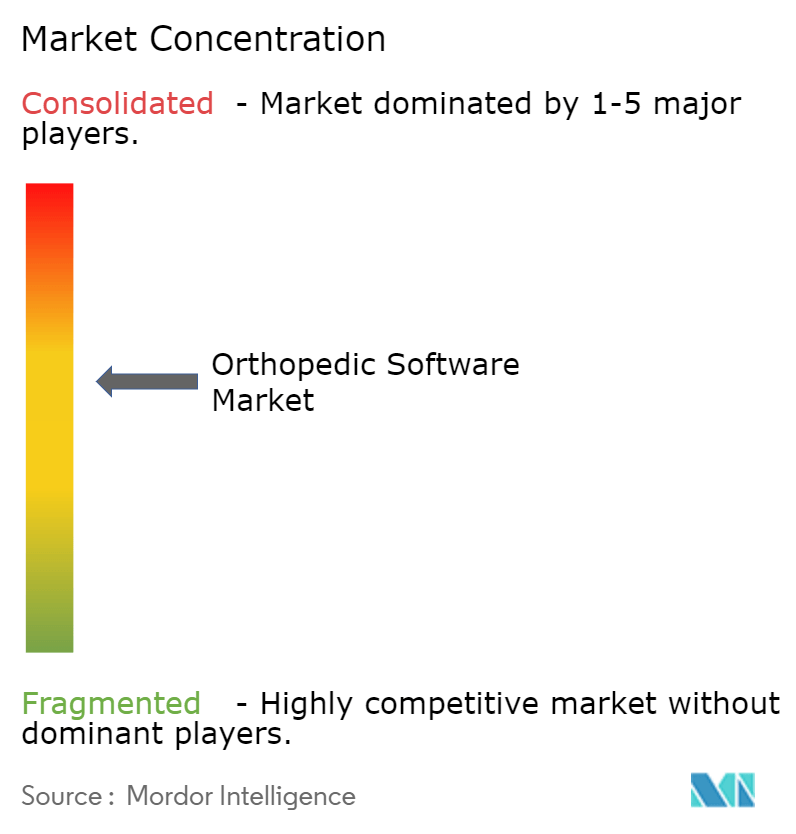
Recent Industry Developments
- March 2025: Stryker showcased next-generation Mako SmartRobotics at AAOS 2025 Annual Meeting, introducing fourth-generation Mako System with expanded applications across hip, knee, spine, and shoulder procedures. The Mako 4 system integrates Q Guidance System technology and includes first-to-market robotic hip revision capability, positioning Stryker for continued market leadership in robotic-assisted orthopedic surgery.
- March 2025: GE HealthCare launched Genesis portfolio, a cloud suite of enterprise imaging SaaS solutions designed to improve patient care coordination and reduce operational costs. The portfolio includes edge data management, cloud storage, vendor neutral archive, and AI-enabled data migration capabilities, targeting to triple GE HealthCare's cloud-enabled offerings by 2028.
- March 2025: ModMed, a leader in specialty-specific healthcare technology, is set to unveil its latest AI-driven advancements at the American Academy of Orthopaedic Surgeons (AAOS) 2025 Annual Meeting. These cutting-edge solutions are designed to enhance efficiency, optimize patient care, and streamline operations within orthopedic practices.By integrating AI-powered automation into clinical workflows, ModMed aims to simplify administrative processes and empower healthcare providers with intelligent decision-support tools.
- September 2024: Arthrex launched OrthoPedia Patient in the United States, an interactive digital platform that offers patients simplified video content on various orthopedic conditions and treatments. This initiative aims to enhance patient education through accessible and comprehensive resources.
- March 2024: Pixee Medical announced the commercial availability of its Knee+ AR computer-assisted orthopedic solution in the USA, designed specifically for Ambulatory Surgical Centers (ASCs). The innovative augmented reality guidance system for total knee arthroplasty will be introduced at the American Association of Orthopaedic Surgeons (AAOS) conference. It offers a streamlined, intuitive solution with real-time 3D positioning through off-the-shelf smart glasses.
Research Methodology Framework and Report Scope
Market Definitions and Key Coverage
Our study defines the orthopedic software market as all purpose-built digital programs that support orthopedic clinical and administrative workflows, including pre-operative templating, orthopedic electronic health records, practice management, orthopedic PACS, and revenue-cycle modules that operate independent of bundled implant hardware. Coverage spans cloud/web and on-premise deployments serving hospitals, ambulatory surgical centers, and specialist orthopedic clinics worldwide.
Scope exclusion: Solutions sold exclusively as embedded firmware inside robotic or navigation hardware are outside the present market frame.
Segmentation Overview
- By Product Type
- Digital Templating / Pre-operative Planning
- Orthopedic EHR
- Orthopedic Practice Management
- Orthopedic PACS
- Revenue Cycle Management
- Other Software
- By Mode of Delivery
- Cloud / Web-based
- On-premise
- By Application
- Orthopedic Surgery
- Fracture Management
- Joint Replacement
- Pediatric Assessment
- Other Applications
- By End User
- Hospitals
- Ambulatory Surgical Centers
- Orthopedic Clinics
- Academic & Research Institutes
- By Geography
- North America
- United States
- Canada
- Mexico
- Europe
- Germany
- United Kingdom
- France
- Italy
- Spain
- Rest of Europe
- Asia-Pacific
- China
- Japan
- India
- Australia
- South Korea
- Rest of Asia-Pacific
- Middle East & Africa
- GCC
- South Africa
- Rest of Middle East & Africa
- South America
- Brazil
- Argentina
- Rest of South America
- North America
Detailed Research Methodology and Data Validation
Primary Research
Mordor analysts conducted structured interviews with orthopedic surgeons, hospital IT directors, and regional PACS integrators across North America, Europe, and Asia-Pacific. These conversations validated procedure growth assumptions, typical license utilization per operating theater, and emerging price structures for cloud subscriptions, closing gaps that desk work alone could not resolve.
Desk Research
We began with public datasets from organizations such as the American Academy of Orthopaedic Surgeons, the National Hospital Discharge Survey, Eurostat procedure files, and the OECD Health Statistics repository, which ground annual surgical volumes and provider counts. Trade associations like the Digital Imaging and Communications in Medicine (DICOM) committee and the Health Information and Management Systems Society supply adoption benchmarks on PACS interoperability and EHR penetration. Company filings, 10-Ks, and investor day decks reveal average selling prices and license mix shifts, while peer-reviewed journals in JAMA Surgery clarify outcome improvements tied to templating accuracy. Select proprietary feeds, notably D&B Hoovers for vendor financials and Dow Jones Factiva for deal tracking, complement public sources and confirm revenue pools. The sources cited here illustrate the broader body of material that Mordor analysts screen and are not exhaustive.
Market-Sizing & Forecasting
A top-down model aligns global joint-replacement and trauma procedure counts with software penetration rates; outputs are cross-checked through sampled bottom-up roll-ups of vendor revenues and channel checks. Key variables in our sheets include average licenses per surgical suite, cloud migration share, median annual maintenance fee, orthopedic surgeon density, regulatory incentives under HITECH meaningful use, and regional GDP per capita health spend. Multivariate regression links these drivers to historical revenue, then an ARIMA overlay projects 2025-2030 trajectories, with scenario bands refined through expert consensus. Where supplier roll-ups underreport developing market activity, we interpolate using device import data and regional ASP benchmarks before final reconciliation.
Data Validation & Update Cycle
Initial outputs pass variance screens against independent indicators such as hospital IT budgets and publicly reported vendor bookings. A senior analyst reviews anomalies, and revisions trigger re-contacts with select experts. We refresh the full model annually and issue interim updates when material events, such as major regulatory shifts or landmark acquisitions, alter fundamentals. Just before publication, an analyst reruns the checks so clients receive the latest calibrated view.
Why Mordor's Orthopedic Software Baseline Earns Trust Across Care Planning
Published estimates frequently diverge because firms differ on what constitutes standalone software revenue, which regions to include, and how quickly cloud conversion unfolds.
Key gap drivers include: alternative studies fold rehabilitation or physiotherapy platforms into scope, assume conservative five-year refresh cadences, or allocate hardware-bundled navigation sales to software. Some also apply straight-line growth from 2018 datasets without primary validation, while Mordor applies current-year expert price discovery and updates currency effects at quarterly rates.
Benchmark comparison
| Market Size | Anonymized source | Primary gap driver |
|---|---|---|
| USD 409.5 million (2025) | Mordor Intelligence | - |
| USD 433.3 million (2024) | Global Consultancy A | Includes rehab software and uses 2018-2023 linear trend with limited expert input |
| USD 454.0 million (2025) | Industry Publisher B | Counts imaging hardware bundles and omits currency realignment checks |
In sum, Mordor's disciplined scope selection, live primary validation, and variable-rich forecasting deliver a balanced baseline that decision-makers can replicate and stress-test with confidence.
Key Questions Answered in the Report
What is the current size of the Orthopedic software market?
The Orthopedic software market is valued at USD 409.49 million in 2025 and is projected to reach USD 592.84 million by 2030.
Which product segment leads the Orthopedic software market?
Digital templating holds the top position with 35.83% share in 2024, owing to its success in cutting implant revision rates.
How fast is cloud deployment growing in orthopedic software?
Cloud-based solutions are expanding at an 11.95% CAGR and already account for 59.32% of 2024 revenue.
Why is fracture management software gaining traction?
AI algorithms detecting fractures with over 90% accuracy and rising trauma cases support a 12.29% CAGR in this application.
Which region offers the highest growth potential?
Asia-Pacific shows a 13.15% CAGR through 2030, fueled by government digitization initiatives in China, Japan, and India.
Page last updated on:



